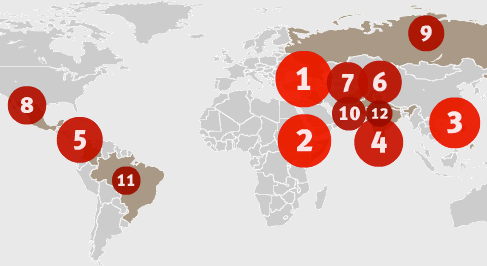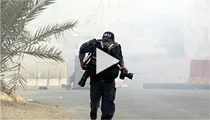Pakistan remained one of the deadliest nations in the world for the press, a situation that appeared unlikely to change given the government’s unwillingness to confront the problem. In March, Pakistan joined with Brazil and India in raising objections to a comprehensive UNESCO proposal to protect the press and combat impunity in journalist murders. Pakistan has been one of the world’s worst nations in combating deadly anti-press violence, CPJ’s Impunity Index shows. At least 23 journalist murders have gone unpunished since the killing of Wall Street Journal reporter Daniel Pearl in 2002. A 2012 report by the Human Rights Commission of Pakistan showed growing ties between political repression and the rising incidence of violence against news media. Threats to journalists in Pakistan were no longer confined to traditionally violent areas such as the border region, the Federally Administered Tribal Areas, or Baluchistan, CPJ research found. Reporters in Islamabad, Peshawar, Quetta, Karachi, and Lahore faced persistent threats. And in another troubling development, several international journalists told CPJ that militants had begun threatening them more frequently, as the groups started paying more attention to their global reputations.
Pakistan
» Government balks at efforts to address persistent anti-press violence.
» Threats spread: Reporters in major cities, international journalists targeted.
Pakistan remained one of the deadliest nations in the world for the press, a situation that appeared unlikely to change given the government’s unwillingness to confront the problem. In March, Pakistan joined with Brazil and India in raising objections to a comprehensive UNESCO proposal to protect the press and combat impunity in journalist murders. Pakistan has been one of the world’s worst nations in combating deadly anti-press violence, CPJ’s Impunity Index shows. At least 23 journalist murders have gone unpunished since the killing of Wall Street Journal reporter Daniel Pearl in 2002. A 2012 report by the Human Rights Commission of Pakistan showed growing ties between political repression and the rising incidence of violence against news media. Threats to journalists in Pakistan were no longer confined to traditionally violent areas such as the border region, the Federally Administered Tribal Areas, or Baluchistan, CPJ research found. Reporters in Islamabad, Peshawar, Quetta, Karachi, and Lahore faced persistent threats. And in another troubling development, several international journalists told CPJ that militants had begun threatening them more frequently, as the groups started paying more attention to their global reputations.
Pakistan is the world's fifth deadliest nation for the press since 1992, CPJ research shows. About 60 percent of the fatalities were targeted murders, with the rest coming during dangerous assignments.
Politics is the most dangerous beat for Pakistani journalists, CPJ research shows, more so than even the coverage of armed conflict.
| 6% | Business |
| 15% | Corruption |
| 21% | Crime |
| 4% | Culture |
| 10% | Human Rights |
| 58% | Politics |
| 42% | War |
* Adds up to more than 100 percent because more than one category applied in some cases
Pakistan is one of the world's worst nations in combating deadly anti-press violence, CPJ's Impunity Index showed. Journalist murders went unpunished over the prior decade with just one exception, the killing of Pearl in 2002.

| 1. Iraq 2. Somalia 3. Philippines 4. Sri Lanka | 5. Colombia 6. Nepal 7. Afghanistan 8. Mexico | 9. Russia 10. Pakistan 11. Brazil 12. India |
Facing threats and violence, numerous Pakistani journalists fled the country between 2007 and 2012, CPJ research shows. Pakistan ranked eighth worst worldwide on this key press freedom indicator.


